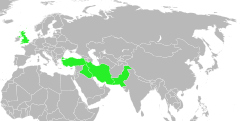- Central Treaty Organization
-
The Central Treaty Organization (also referred to as CENTO; original name was Middle East Treaty Organization or METO; also known as the Baghdad Pact) was formed in 1955 by Iran, Iraq, Pakistan, Turkey, and the United Kingdom. It was dissolved in 1979.
U.S. pressure and promises of military and economic aid were key in the negotiations leading to the agreement, although the United States could not initially participate "for purely technical reasons of budgeting procedures."[1] In 1958, the United States joined the military committee of the alliance. It is generally viewed as one of the least successful of the Cold War alliances.[2] The organization's headquarters were initially located in Baghdad (Iraq) 1955–1958 and Ankara (Turkey) 1958–1979. Cyprus was also an important location for CENTO due to its positioning within the Middle East and the British Sovereign Base Areas situated on the island.[3]
Contents
History
Modeled after the North Atlantic Treaty Organization (NATO), CENTO committed the nations to mutual cooperation and protection, as well as non-intervention in each other's affairs. Its goal was to contain the Soviet Union (USSR) by having a line of strong states along the USSR's southwestern frontier. Similarly, it was known as the 'Northern Tier' to prevent Soviet expansion into the Middle East.[4] Unlike NATO, CENTO did not have a unified military command structure, nor were many U.S. or UK military bases established in member countries, although the U.S. had communications and electronic intelligence facilities in Iran, and operated U-2 intelligence flights over the USSR from bases in Pakistan. The United Kingdom had access to facilities in Pakistan and Iraq at various times while the treaty was in effect. In addition, Turkey and the U.S. agreed to permit American access to Turkish bases, but this was done under the auspices of NATO.
On July 14, 1958, the Iraqi monarchy was overthrown in a military coup. The new government was led by General Abdul Karim Qasim who withdrew from the Baghdad Pact, opened diplomatic relations with Soviet Union and adopted a non-aligned stance; Iraq quit the organization shortly thereafter. The organization dropped the name 'Baghdad Pact' in favor of 'CENTO' at that time.
The Middle East and South Asia became extremely volatile areas during the 1960s with the ongoing Arab-Israeli Conflict and the Indo-Pakistani Wars. CENTO was unwilling to get deeply involved in either dispute. In 1965 and 1971, Pakistan tried unsuccessfully to get assistance in its wars with India through CENTO, but this was rejected under the idea that CENTO was aimed at containing the USSR, not India.
CENTO did little to prevent the expansion of Soviet influence to non-member states in the area. Whatever containment value the pact might have had was lost when the Soviets 'leap-frogged' the member states, establishing close military and political relationships with governments in Egypt, Syria, Iraq, the People's Democratic Republic of Yemen, Somalia, and Libya. Indeed, by 1970, the U.S.S.R. had deployed over 20,000 troops to Egypt, and had established naval bases in Syria, Somalia, and P.D.R. Yemen.
The Iranian revolution spelled the end of the organization in 1979, but in reality, it essentially had been finished since 1974, when Turkey invaded Cyprus. This led the United Kingdom to withdraw forces that had been earmarked to the alliance,[citation needed] and the United States Congress halted Turkish military aid despite two Presidential vetoes.[4] With the fall of the Iranian monarchy, whatever remaining rationale for the organization was lost. Future U.S. and British defense agreements with regional countries — such as Pakistan, Egypt, and the Persian Gulf states — were conducted bilaterally.
Google News reprints of the Virgin Islands Daily News (Feb 17, 1979) and Los Angeles Times (Feb 15, 1979) indicate that with the withdrawal of Iran, the secretary-general of CENTO, a Turkish diplomat, called a meeting of the pact's council in order to formally dissolve the organization.
Timeline
- 1954 February: Turkey signs a Pact of Mutual Cooperation with Pakistan.
- 24 February 1955: A military agreement is signed between Iraq and Turkey, and the term "Baghdad Pact" starts to be used. Iran, Pakistan and the United Kingdom join the Baghdad Pact.
- 1959 March: The new republican regime of Iraq withdraws the country from the alliance.
- 1965: Pakistan tries to get help from its allies in their war against India, but without success.
- 1971: In a new war with India, Pakistan again tries unsuccessfully to get allied assistance. (The U.S. provides limited military support to Pakistan, but not under the rubric of CENTO.)
- 1979: The new Islamic regime of Iran withdraws the country from CENTO.
See also
- NATO
- SEATO
- ANZUS
- Organization of American States
- NORAD
References
- ^ Hadley, Guy. CENTO: The Forgotten Alliance ISIO Monographs, University of Sussex, UK (1971): 2.
- ^ Martin, Kevin W. (2008). "Baghdad Pact". In Ruud van Dijk et al.. Encyclopedia of the Cold War. New York: Routledge. pp. 57. ISBN 9780415975155. http://books.google.com/books?id=rUdmyzkw9q4C&pg=PA57&dq=cento+%22least+successful%22+%22baghdad+pact%22&client=safari. Retrieved 2009-01-30. "Thus, the Baghdad Pact is widely considered the least successful of the Cold War schemes engendered by the Anglo-American alliance."
- ^ Dimitrakis, Panagiotis, "The Value to CENTO of UK Bases on Cyprus", Middle Eastern Studies, Volume 45, Issue 4, July 2009, pp 611–624
- ^ a b George Lenczowski, American Presidents and the Middle East, 1990, p.88
External links
- Central Treaty Organization (CENTO)[dead link] entry in Encyclopaedia Iranica
 Treaties of Turkey
Treaties of TurkeyDuring the War of Independence After Proclamation of the Republic Balkan Pact • Montreux Convention • Treaty of Saadabad • Nyon Arrangement • German–Turkish Non-Aggression Pact • CENTO • Zürich and London Agreements • Ankara Agreement • RCD Treaty • Bosporus Statement (BSEC) • ECO Treaty • The Agreement on Strategic Partnership and Mutual SupportCategories:- 1955 in law
- Cold War treaties
- History of the United States (1945–1964)
- Former international organizations
- International military organizations
- 20th-century military alliances
- 1979 disestablishments
- International organizations established by treaty
- Organizations established in 1955
- 1955 in international relations
- Iraq–United Kingdom relations
- Treaties of Iraq
- Military alliances involving the United Kingdom
- Military alliances involving Iraq
- Military alliances involving the United States
- Military alliances involving Iran
- Military alliances involving Pakistan
- Treaties of Pakistan
- Treaties of the Pahlavi dynasty
- Treaties of Turkey
- Treaties of the United Kingdom
Wikimedia Foundation. 2010.



